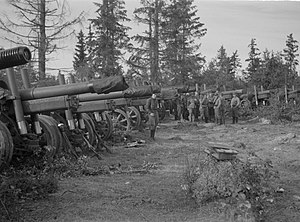Winter War
Territorial disputes between the Soviet Union and Finland caused the outbreak of the Winter War in November 1939. Several months of fighting ensued, during which the Red Army was able to push back the Finnish defenders on the Karelian Isthmus. Located on the main road to the vital port of Vyborg, the town of Porlampi was occupied by the Soviets in March 1940 following the Battle of Summa. [4]
Following the end of the Winter War in March 1940, Finland was forced to cede part of Karelia to the Soviet Union, with Porlampi being one of the territories handed over. [5] [4]
Continuation War
On 22 June 1941 the German Wehrmacht launched Operation Barbarossa, the planned invasion of the Soviet Union. Prior to the commencement of Barbarossa, Finnish and German officers had planned for possible Finnish participation in the war against the Soviet Union. Finland mobilized 16 infantry divisions, one cavalry brigade, and two jäger brigades of the Finnish Army to the newly established border with the Soviets on 21 June, and on 22 June conducted Operation Kilpapurjehdus, an action that violated the Moscow Peace Treaty. [5] That same day, German naval bombers began mining the waters around Leningrad, with some of the aircraft being deployed from airfields in Finland. [6] On 25 June a flight of Soviet bombers struck at airfields in Finland, and Soviet artillery stationed in Hanko fired on Finnish targets. [7]
With the border situation growing more volatile, the Finnish Army prepared to enter the widening conflict. On 29 June Carl Gustaf Emil Mannerheim, Marshal of Finland, formed the Army of Karelia under the command of Erik Heinrichs. Combat operations against the Red Army and Air-force commenced on 1 July, and war was declared that same day. The first Finnish offensive into Ladoga Karelia began on 10 July, a move that split the zones of Soviet occupation in Karelia into separate fronts. Despite Finnish success in other areas, the IV Corps was unable to begin its advance against the Soviets until the II Corps reached the northern shore of Lake Ladoga on 9 August. [3]
Once the offensive began, the objective of the IV Corps was the recapture of the town of Vyborg. [3] Plans were made to begin an offensive on 15 August, but movement by Soviet troops changed the situation. The Soviet 23rd Army withdrew some of its divisions from the Finnish border, seeking to use the narrow part of the Karelian Isthmus to better utilize their numerical superiority for defense. [8] The Finns postponed their offensive until the Soviets had abandoned their fortifications, finally striking on 21 August. The Finnish plan had been modified as the situation changed; rather than assault Vyborg, the IV Corps would now maneuver around the northern flank of the city and pursue the withdrawing Soviets to the Vuoksi River. [3] [9]
The main body of the Finnish IV Corps crossed the border to the north of Vyborg on 22 August, and continued to advance towards the Vuoksi River in the opening days of the offensive. On 24 August the Finnish 8th Division crossed Viipuri Bay, landing to the south of Vyborg and cutting the coastal road to the city. [10] Hoping to re-establish the road link to Vyborg, the Soviet 43rd, 115th and 123rd Rifle Divisions launched a counter-offensive directed at the Finnish 8th Division. Though heavily outnumbered, Finnish Light Brigade T stalled the Soviets for a few crucial hours while IV Corp advanced southward on 25 August. [11] For the next few days both armies drew up their forces and prepared for an engagement in the heavily forested terrain around the town of Porlampi, which was positioned between the coastal and central Karelian highways. [3]


